|
City of Prineville Railway |
|
|
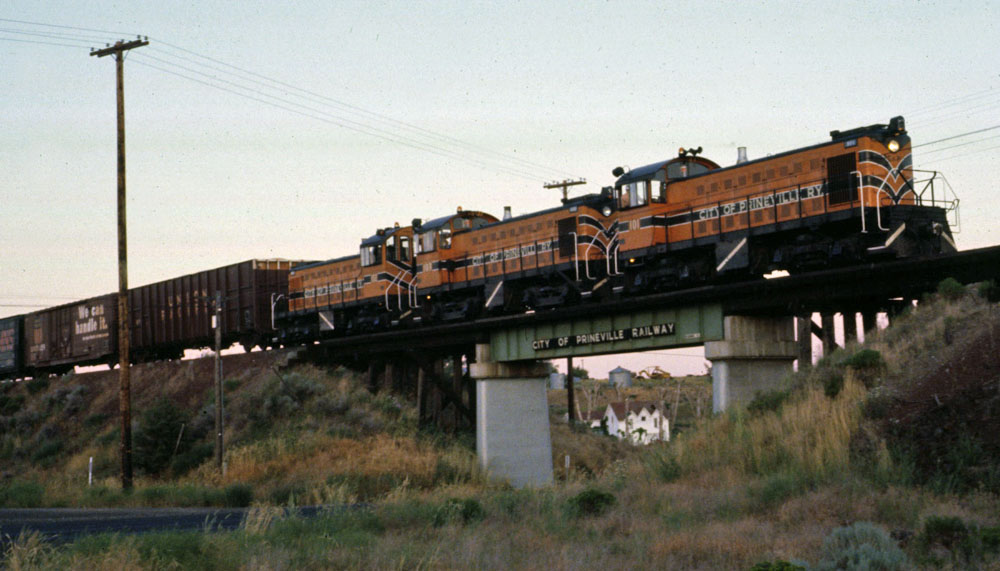 |
|
All three Alco switchers owned by the City of Prineville lead a Prineville-bound train across the Highway 26 bridge. Photo by and courtesy of Louis K. Thelen. |
|
|
History In 1868 Francis B. Prine built a small cabin in the meadows where Ochoco Creek emptied into the Crooked River. Two years later he built a store and a saloon. Another party built a second store in 1871, and a community was born. The community gained a post office on 13 April 1871 under the name "Prine". The U.S. Post Office apparently had difficulty with the name, and on 23 December 1872 they changed the name of the post office to Prineville. The Prineville townsight was surveyed in 1871, and the town plat was filed in 1877. The City of Prineville was incorporated in 1880. Prineville quickly grew to be the center of commerce in central Oregon, and the community grew. The population of the town was 200 people in 1876, 400 in 1880, 656 in 1900, and 1,042 in 1910. All roads through the territory passed through Prineville, and the town became the supply source for the dominant industry in the area, which was sheep and cattle ranching. The Oregon State Legislature created Crook County in 1882, and Prineville became the permanent county seat in 1883. As the most prominent town in central Oregon, the citizens of Prineville felt that their town would be on the route of any railroad that would be built into or through Central Oregon. There were many early proposals to build railroads through the region, and every one projected a line either terminating in or passing through Prineville. However, the citizens were continually disappointed as every projected line either never got started or halted construction well short of the region. |
|
|
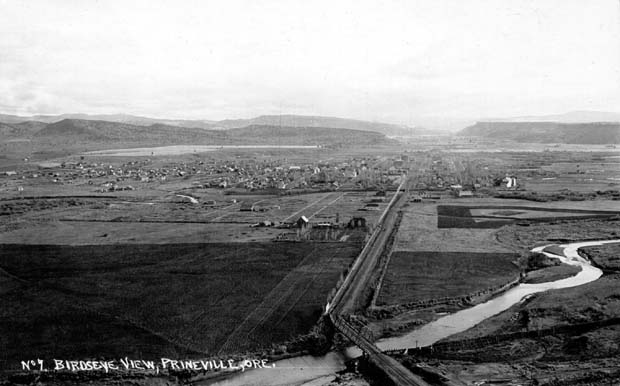
|
|
The City of Prineville as it appeared sometime before 1910. Photo from the Martin G. Morisette collection. |
|
|
|
The logjam finally broke in July 1909 when suddenly not one but two railroads started building parallel
lines down the Deshutes River canyon from the mouth of the Columbia River. The two railroads were the
Oregon Trunk (OT), which was controlled by railroad magnate James J. Hill, and the Des Chutes Railway,
which was controlled by competing railroad magnate Edward Henry Harriman's Union Pacific (UP). Excitement
in central Oregon grew as the construction on these two line progressed. However, Prineville's excitement
quickly turned to bitter disappointment as the two railroads bypassed Prineville in favor of the new town
of Bend, which was located on the Deschutes River 35 miles southwest of the city. The two competing
railroads eventually inked a deal that saw the two companies use one route combined from the best portions
of the two partially completed routes. James J. Hill drove the final spike completing the railroad into
central Oregon at Bend on 5 October 1911. Prineville had been snubbed. The city felt helpless, and almost as soon as the railroad to Bend was finished businesses started moving from Prineville to the town that had a railroad. The usual fate of any established community left off the line of a railroad at the time was at best a quick death and at worst a long, slow decline. Bend quickly captured most of the trade business that Prineville depended on, and then other communities located along the railroad started siphoning off what was left. Prineville needed a railroad to stay alive, and the citizens initially pegged their hopes on a branchline to be built by one or both of the railroads operating to Bend. However, neither of the big roads showed any interest in building such a branchline. The townspeople gradually came to realize that if the town was to survive it needed a railroad, and if no one else was going to build a railroad to them then they would have to build one themselves. |
|
|
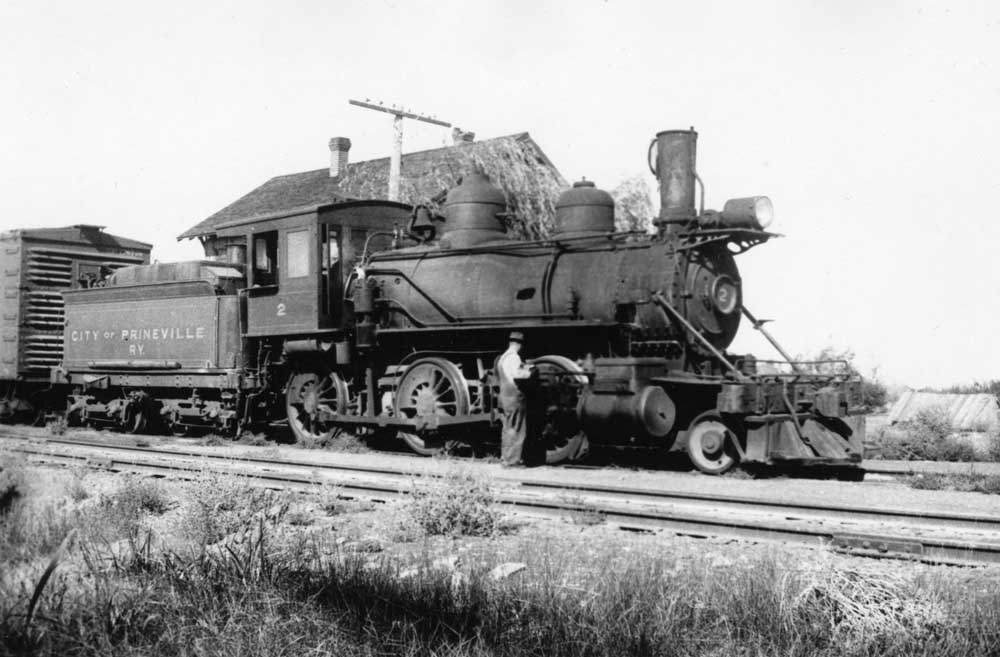
|
|
City of Prineville #2 at Prineville Junction. Jerry Lamper collection. |
|
|
|
Local concerns started thinking about building a railroad out of the city around 1909. Various groups
of citizens formed two companies, the Prineville & Eastern in 1911 and the Metolius, Prineville &
Eastern in 1912. The MP&E actually raised money and secured a right-of-way, but the company collapsed
in 1914. There were a couple additional plans and attempts, but nothing came of any of them. It became
increasingly clear that private investment in a railroad to Prineville was not easily forthcoming. If private investment did not work, then public investment might, and that avenue became the last possible hope for construction of railroad to Prineville. The city council discussed the idea and examined the results of other such municipally built shortline railroads around the nation. On 3 March 1916 the council passed Ordinance #231, which authorized the city to build a railroad line, to sell or lease it to private enterprise upon completion, to issue $100,000 in bonds to finance construction, and to levy taxes to cover bond obligations. The ordinance went to the voters in a special election held on 28 March 1916. The ordinance passed by a vote of 355 to 1. The city council confirmed the bonds issue on 2 May and called for bids for the bonds. However, no bids were forthcoming, and the first attempt failed. On 7 July 1916 the council passed Ordinance 234, which authorized the same thing as Ordinance 231, but contained some provisions to make the bonds more appealing. This ordinance also went to the voters, who approved it by a vote of 358 to 1. A buyer was found for the second set of bonds, and the city council finalized the action on 20 January 1917. |
|
|
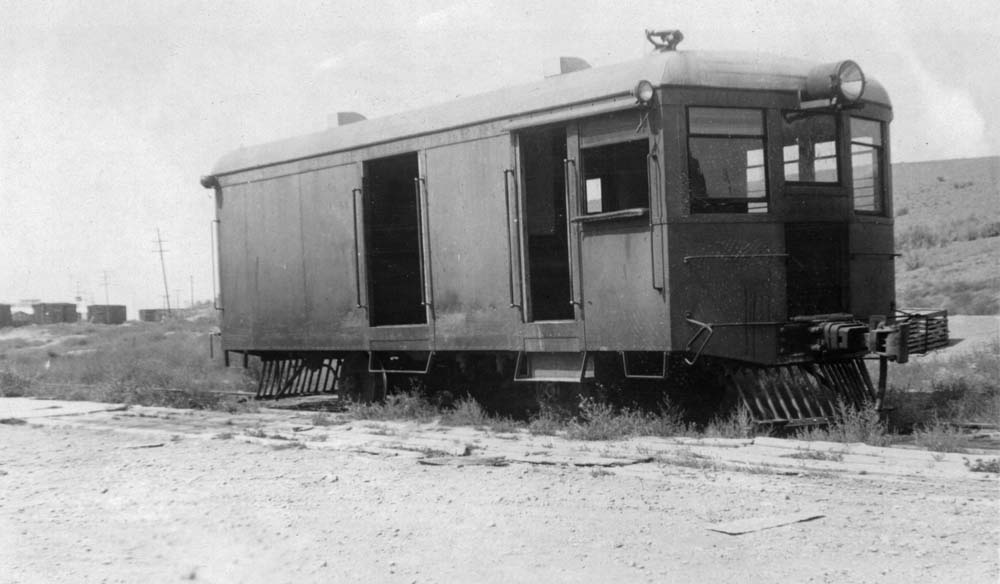
|
|
A small railbus that provided passenger service through much of the railroad's early history. Jerry Lamper collection. |
|
|
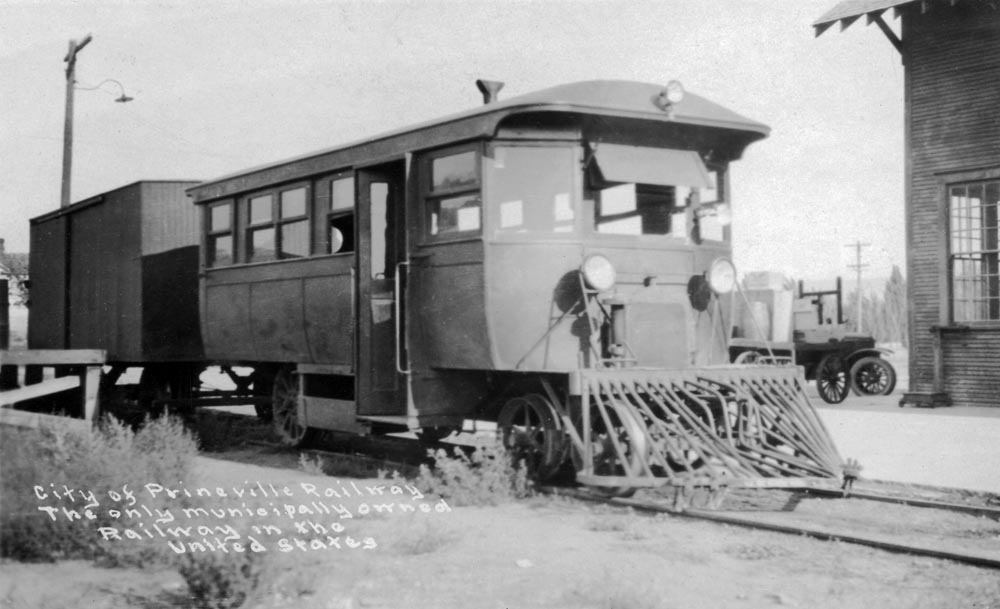
|
|
Another railbus used for early passenger service, this one equipped with an extra trailer. Jeff Moore collection. |
|
|
|
City engineer H. A. Kelley, W. E. Burkhalter of the Spokane, Portland & Seattle Railroad, and H. J.
Roberts of the Oregon-Washington Railway & Navigation Company selected the route of the new railroad.
The selected route crossed the Crooked River just west of Prineville and then followed the river for a
dozen miles to the crossroads known as O'Neil. From O'Neil the railroad climbed a 2.5 percent grade to
get out of the canyon. Once out of the canyon the railroad made a short flat run to a connection with the
joint Oregon Trunk/Union Pacific line about halfway between Redmond and Terrebonne at a point that became
known at Prineville Junction. The city council authorized its attorney to obtain right-of-ways in October
1916. The city council asked landowners to donate right-of-ways with a great deal of success, with right-of-ways
condemned across lands owned by those who would not donate to the cause. Grading the line came next, and
E. T. Johnson and Son, a Portland-based contractor, beat out four other bidders. Grading started on 2 April
1917 in Prineville, with the grade completed in December. The city opted to lay rails with its own forces,
but the company quickly ran into trouble obtaining the needed materials. By this point World War I was
in full swing, and any rail purchases had to be approved by the U.S. Government. The city obtained approval
to obtain the needed rails only after one of Oregon's Senators intervened. The Oregon Trunk and Union
Pacific companies agreed to lease rails to the city. City construction crews laid the first rails at
Prineville Junction on 30 May 1918, and the line was completed in early August. The next month was spent
dumping ballast and doing other work needed to get the new property ready for operation, and the first
revenue movements rolled over the new railroad in mid-August, regular freight service was established by early
September, and regular passenger service was established by the following April. Increased prices on
everything caused by the on-going war meant that the city was paying far more for everything that what it
had planned, with the result that the city had to approve two more bond issues to secure the needed money.
The voters passed the first bond in September 1918 by a vote of 127-9 and the second bond in March 1920.
The city spent a total of $325,000 building the line. Prineville finally had its railroad. The city council set up a railroad commission on 6 August 1918 and turned operations over to the new entity on 21 April 1919. The city intended to sell the railroad to private owners once the line was built, but the only investor who expressed interest in purchasing the line from the city elected not to pursue the deal. The city resigned itself to operating the railroad it had built. To start operations the new railroad purchased a new gasoline powered railbus from the White Company, a used steam locomotive, and a used passenger coach. The initial schedule implemented on 13 April 1919 saw four trains a day each way across the railroad, with two of the round trips made with a mixed train and the other two round trips made with the railbus. However, traffic did not live up to expectations, and the frequency of service gradually decreased. Early freight traffic was about two thirds seasonal livestock movements, with a number of different commodities (mostly inbound merchandise) making up the rest. |
|
|
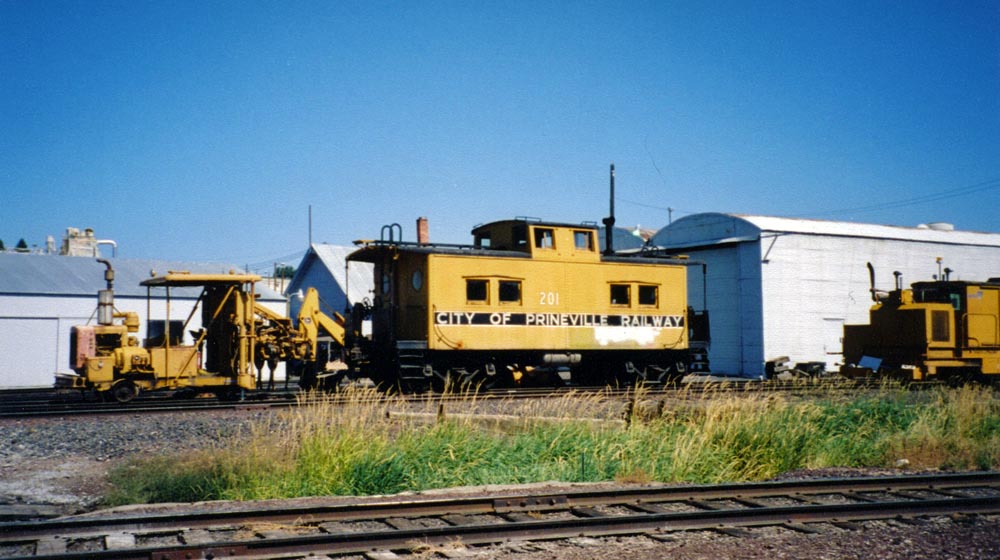 |
|
City of Prineville's ex-Lehigh Valley caboose #201 sitting in front of the Prineville shop buildings in August 2004 Jeff Moore photo. |
|
|
|
The city built the railroad with the expectation that the line would be able to pay its own way. Initial
financial reports indicated that the line might be able to do that, but after a year or two of profitable
operations the sudden influx of cars and improved roads caused the bottom to fall out of the passenger
business, which provided the bulk of the revenue in the early years. The railroad started losing money
by the early 1920s, forcing the city to advance money to the railroad. The railroad was in quite a financial
hole by the mid-1920s, but was able to nearly climb out of that hole when the Depression hit. In May 1931
the city council started budgeting monthly amounts to cover the mounting deficits incurred by the railroad.
Further efforts to sell or lease the railroad to private interests yielded some discussions but no deals, and
the city maintained ownership and operation of the railroad. One of the biggest financial obligations faced
by the railroad and the city was interest on the construction era bonds, and in 1938 the city refunded the
bonds at a much lower interest rate to reduce the crushing burden of meeting the interest payments. Through
this entire period railroad expenses were kept at absolute minimums, with all maintenance expenses limited
to what was absolutely necessary to keep the railroad going. The city did briefly experiment with an
ordinance levying a tax on all freight shipments to and from Prineville shipped via means other than the
City of Prineville Railroad, but the tax did more harm than good and was quickly repealed. The city put up with the railroad and its losses for one reason. The Ochoco Mountains east of the city were covered with a thick blanket of fine forests, mostly owned by the U.S. Forest Service. The city knew that sooner or later those forests would be opened to harvesting and that sawmills would be needed to turn logs into lumber. Prineville was the ideal place to locate such sawmills, but without a railroad the mills and their attendant jobs would bypass the town in favor of locations along the mainline railroads to the east. The first lumber mill to ship finished products went into operation in 1925. Sawmill operations gradually expanded. New larger mills came on line in 1938, and by 1940 four large mills were up and running. However, by this point the deferred maintenance of the previous decade and a half meant that the line was in terrible condition. Ties and rail were bad, ballast was non-existent, and the equipment and rolling stock was in poor shape. The railroad borrowed $28,000 from the two connecting mainline roads in 1938 to do work on the worst spots. The mainline roads also built a new $30,000 scale in Prineville so that the shortline could deliver cars to them already weighed. The railroad earned a small profit in 1939, its first since 1920. 1939 also saw the end of passenger operations. |
|
|
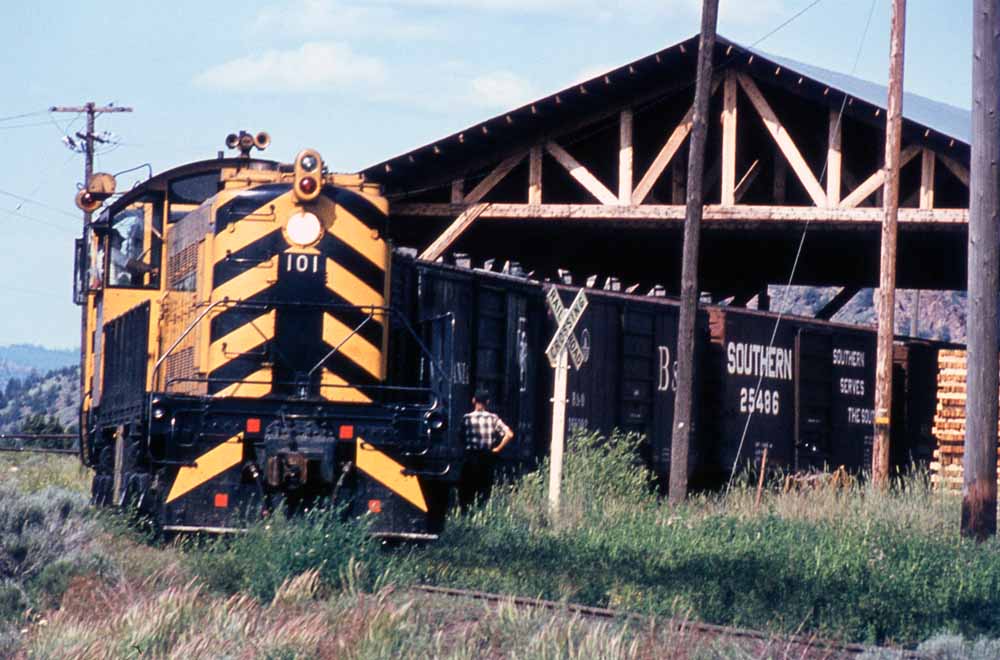
|
|
City of Prineville #101 switching in Prineville. Jeff Moore collection. |
|
|
|
World War Two had little impact on the railroad's traffic levels, which remained at record levels. However,
shortages of men and materials forced the railroad to neglect its property, and by the end of the war
the tracks and equipment were once again in poor shape. Derailments became common, and the city started
receiving immense pressure from the lumber companies and regulatory agencies to fix the tracks. Finally in 1945 the city was in a
position to start the re-building and re-equipping of the entire railroad. The entire railroad was re-built,
the old and frail bridge across the Crooked River was replaced, and serviceable locomotives were purchased
to replace the older, worn out power. The livestock business, long a staple of the company, finally disappeared
in the early 1950s, but the lumber and forest products business remained strong. Profits on the railroad
became a normal event, eventually allowing for the repayment of the last of the construction era bonds in
1960. Profits from the railroad allowed the city to remove all property taxes for a while in the 1960s and
1970s. The railroad purchased its first diesel locomotive in 1950, and it scrapped the last steam locomotive on the property in 1955. Operations during the early to mid-1950s saw two round trips a day to Prineville Junction, one during the day and one at night. A decrease in lumber loads allowed the railroad to run only one train a day starting around 1960, but by the late 1970s the company was back to running two trains a day over the railroad. Traffic through this period was almost all lumber and woodchips, with occassional inbound loads of tires bound for tire giant Les Schwab. Lumber moved both inbound and outbound over the railroad, as there were a number of millwork facilities in Prineville that received rough cut lumber for futher milling. In 1978 the railroad served nine lumber related facilities in Prineville. The railroad did make one foray back into the passenger business in 1964 when the railroad purchased a streamlined coach from the Union Pacific for $5,400. The coach was used to handle special charters by civic groups and others. This coach lasted into the mid-1970s, when it was retired and scrapped. The City of Prineville Railroad also entered the incentive per diem boxcar craze of the late 1970s with the lease of 400 modern 50-foot double door boxcars from Itel in 1977. These boxcars were painted orange and featured a large map of the state of Oregon with the location of Prineville marked on the map. |
|
|
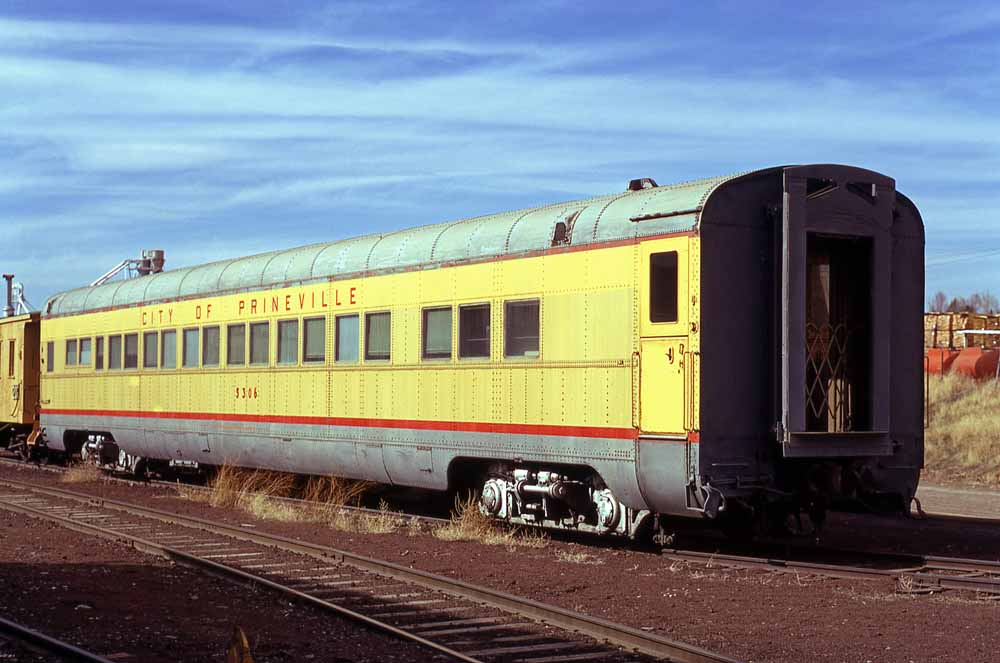 |
|
The coach the City of Prineville bought from the Union Pacific in 1964 for a reported $5400. The coach would be added to Friday night freights and special excursions, all of which the railroad provided free to the public, until the service ended around the middle 1970s. Jeff Moore collection. |
|
|
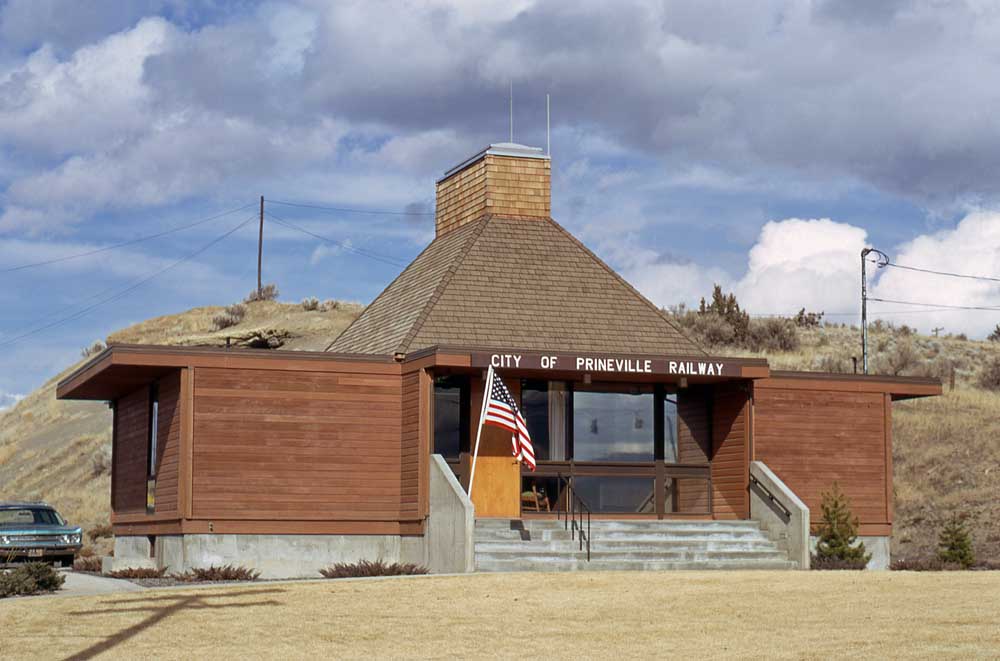 |
|
City of Prineville's office building around 1972. Jeff Moore collection. |
|
|
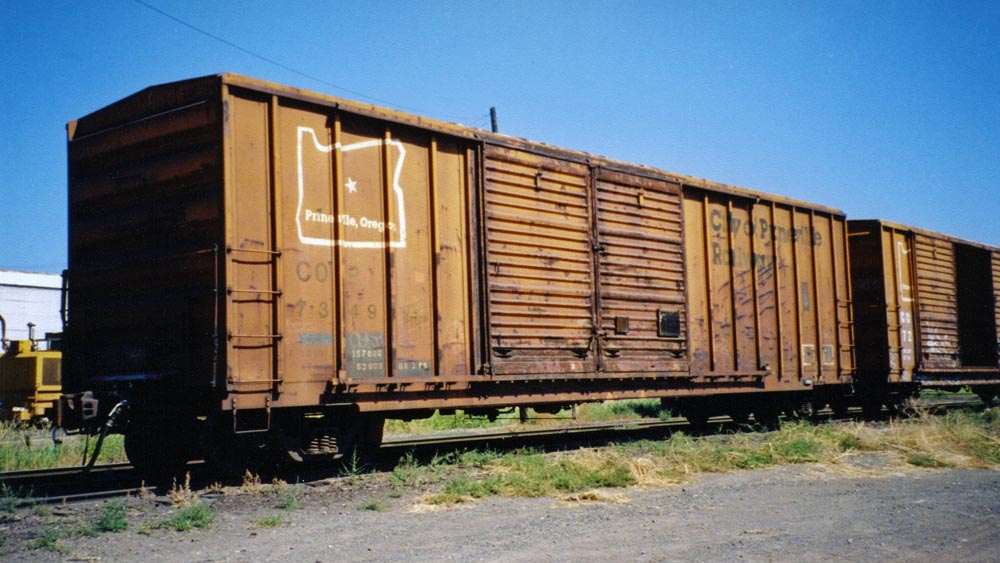 |
|
City of Prineville Railroad boxcar #7349 sitting on a siding in Prineville in August 2004. At one point the railroad fielded a fleet of 400 of these cars; only 139 were left at the time of this photo, all leased from GE Capital. All cars have since left the roster and property. Jeff Moore photo. |
|
|
|
The railroad entered the 1980s on a slower pace. The line was once again re-built with heavier rail and new ballast. Four forest products shippers remained active in Prineville. By the dawn of the 1990s the railroad counted only two remaining sawmills as shippers, plus one millworks company that received inbound loads of lumber. There were some other scattered shippers, but none of them had any real major impact on the railroad. The railroad handled an average of 2,500 carloads a year through the 1980s and 1990s. Passenger operations returned to the railroad in 1989 when a private company, Rimrock Scenic Rail Tours, started the Crooked River Dinner Train. The dinner train initially used a cars leased from the Pacific Northwest Chapter of the National Railway Historical Society. The company eventually purchased its own ex-Milwaukee Road cars. The next major change came in 1994 when the company became the new home for Mt. Emily Lumber Company 3-truck Shay #1. The Oregon Historical Society owned the Shay and had leased it out to the Cass Scenic Railway in West Virginia for 20 years. In 1993 the society elected to return the locomotive back to Oregon, and the City of Prineville won the right to host the locomotive. Private interests purchased a couple log cars and a "logger's special" ballast hopper to go with the locomotive, and it hauled a number of special photo freights in addition to occassional special passenger excursions. |
|
|
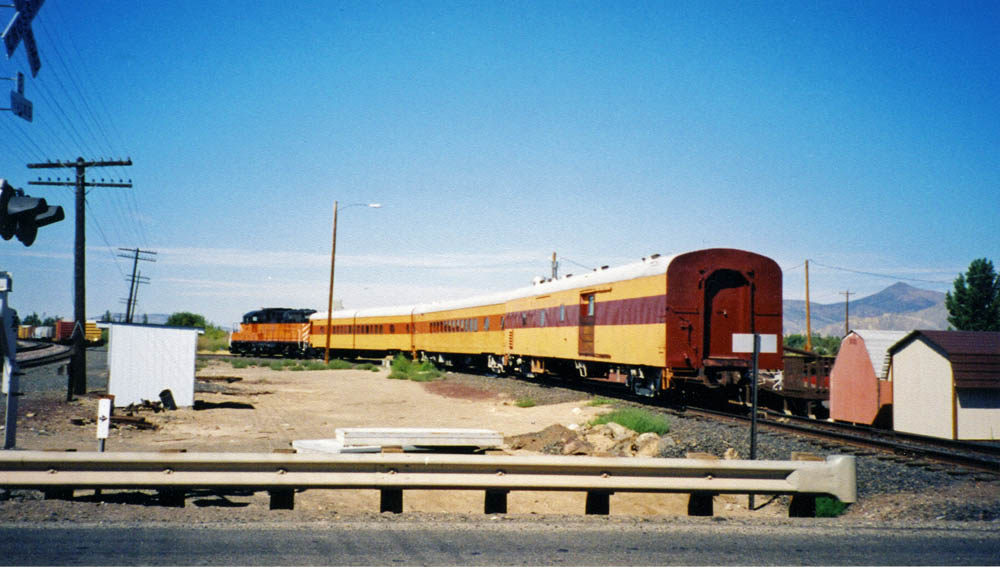 |
|
The Crooked River Dinner Train sitting in Prineville Juntion in August 2004 Jeff Moore photo. |
|
|
The bottom fell out of the freight business in 2001. The two remaining sawmills on the line at the time
were operated by the Ochoco Lumber Company and Crown Pacific. The first of the two to go was the Ochoco
Lumber Company, which closed for good on 1 August. Ochoco Lumber Company was good for 800 loads a year,
and its loss hurt the railroad significantly. The other shoe dropped on 22 August when Crown Pacific
announced that they would be closing their Prineville mill within 60 days. Crown Pacific closed its doors
and shipped its last loads in October of 2001. Traffic on the railroad dropped from 2,500 loads a year
to less than 100, almost entirely inbound lumber destined for Woodgrain Millworks. By this point the
railroad had a $5 million emergency reserve fund built up. The railroad elected to live off that while
it searched for new revenue. Financial results on the railroad through the next several years were dismal. The railroad lost $305,000 in 2002, $572,000 in 2003, and around $100,000 in 2004. The only real bright spot for the railroad during this time came in late 2002 when the railroad handled many loads of inbound logs. The logs had been harvested in the burned areas of a couple Arizona Indian reservations during that summer, and the affected tribes elected to salvage the burned timber and sell it to various sawmills up and down the west coast. The vast majority of this burned timber was sold to Sierra Pacific Industries, who shipped the logs by rail to their sawmills in Susanville, Chinese Camp, and Standard, CA. The logs handled by the City of Prineville were reloaded onto trucks in Prineville for delivery to a small sawmill in Prairie City, OR. This movement was a one time event, and once the last of the logs arrived the traffic was gone. Expenses were again cut to the bare bones. The railroad's management considered many options to make the railroad profitable again, and by late 2003 things began to fall in place. The first positive came when the railroad opened a new transloading facility in an abandoned sawmill complex. The facility quickly landed its first steady customer, the Louisiana Pacific laminates plant in Hines, OR, which started receiving six or seven loads of veneer and shipping out four loads of laminated beams each week. L-P used trucks to transport their products between Hines and Prineville. The next moves came during the closing months of 2004 when the railroad inked two more deals, one to move tires for Les Schwab Tire Company and the other to purchase the Crooked River Dinner Train. Some of these advances have been short lived, however, as L-P has since closed the Hines plant and the dinner train ceased operations in late 2008. The dinner train remained closed for only a short time, however, as a private party stepped in to take it over. Unfortunately, the private party could not make a go of the operation either and soon ceased operations. The railroad sold the two dining cars in November 2011 to the Mt. Rainier Scenic Railroad of Mineral, Washington, which has eliminated regular passenger service from the railroad. |
|
|
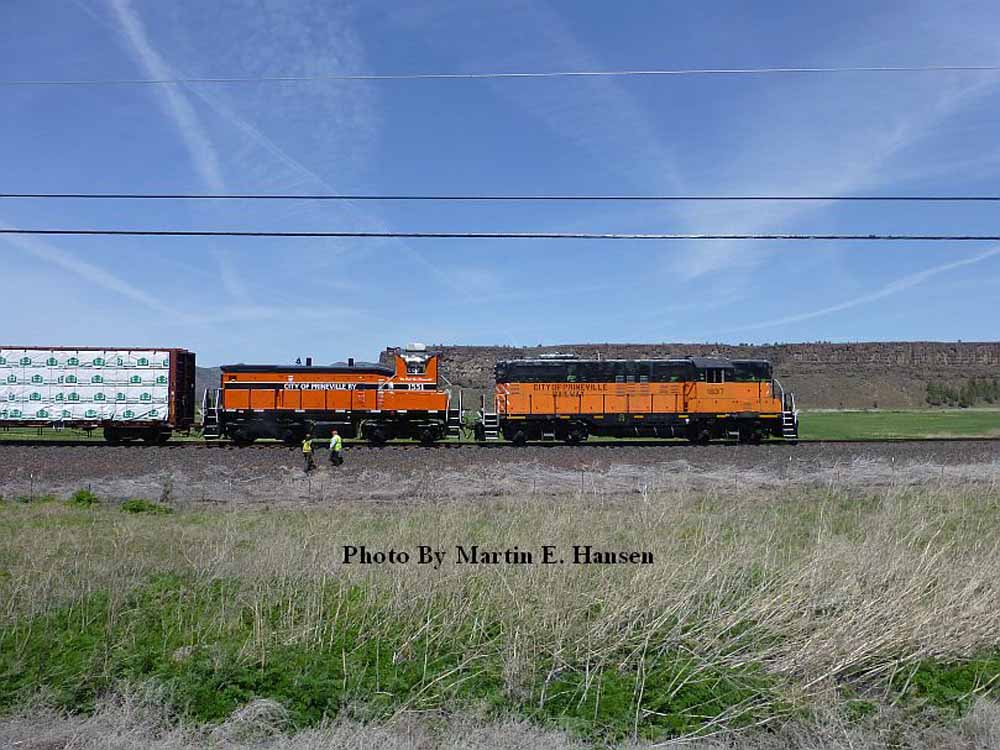 |
|
The railroad as part of its revival acquired a former Southern Pacific SW1500 switcher, seen here arriving on the property for the first time on 12 May 2014. Martin E. Hansen photo. |
|
|
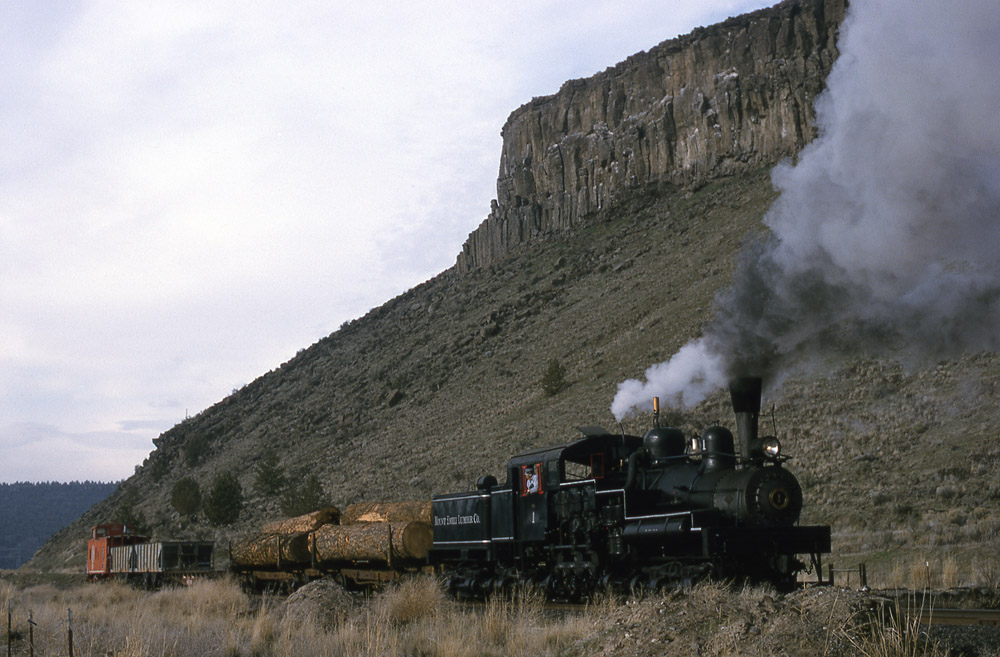 |
|
The Mt. Emily Shay leads a chartered photo freight on 25 February 1995. Keith Ardinger photo. |
|
|
The City of Prineville continues to be one of the oldest municipally built and operated railroads in the
United States. The railroad has reshaped itself into a distribution center serving all of central and eastern
Oregon, with most freight passing through two reload centers. The original reload at the Prineville Freight Depot
ships and receives a wide variety of products, while bulk and liquid products move through a second reload the company
built at Prineville Junction. The company generates additional substantial revenues through commercial car storage on
the many idled industrial spurs and sidings. The railroad has successfully pursued additional grant monies to upgrade its track
structure, and the company is now back on a firm financial footing. The Mt. Emily Shay remained on the property and
operated a couple times a year for passenger excursions or other civic events until 1 September 2022 when the Oregon
Historical Society conveyed the locomotive to the Oregon Rail Heritage Foundation, which moved it to the Oregon
Rail Heritage Center in Portland, Oregon, at the end of 2023. |
|
|
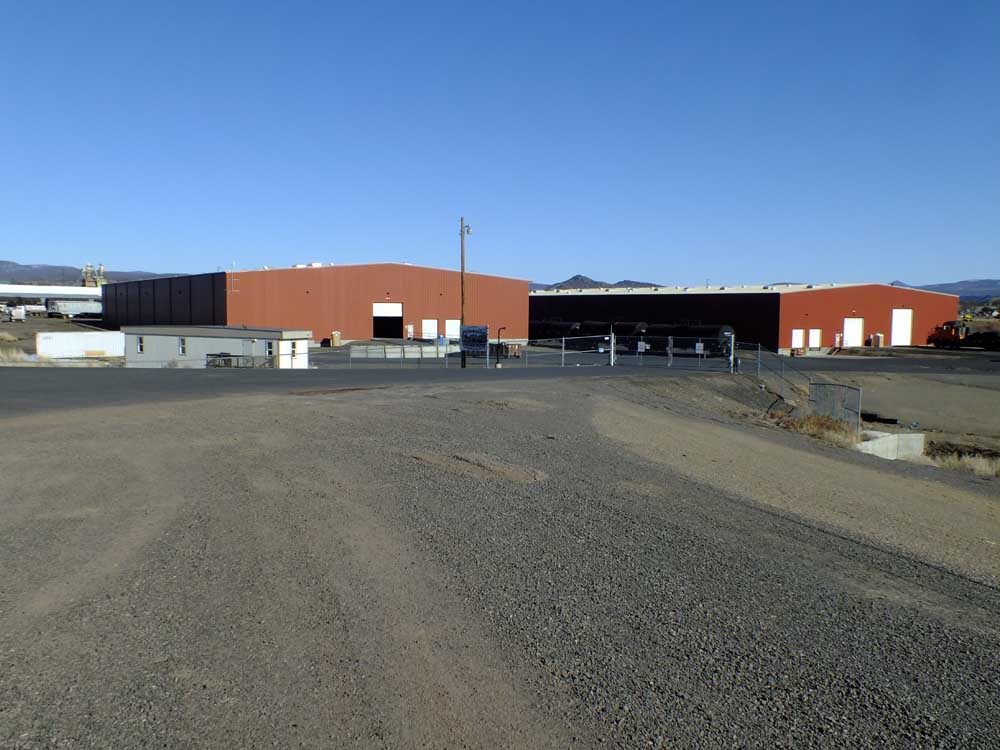 |
|
An overview of the Prineville Freight Depot, the reason for the railroad's continued existence. |
|
|
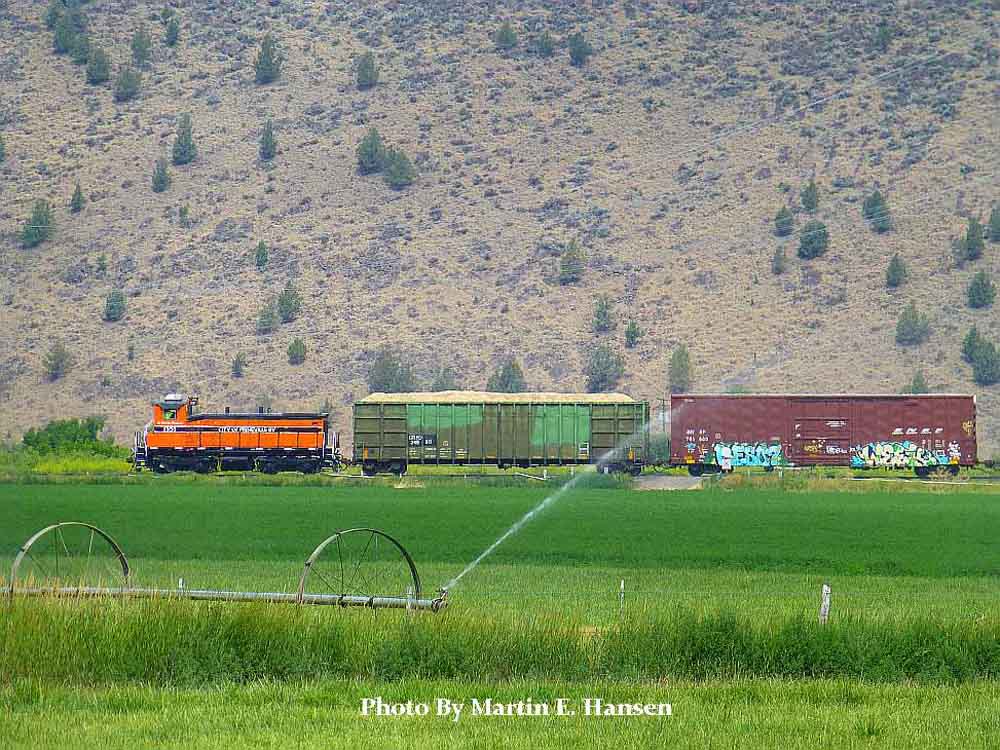 |
|
COP #1551 leading a freight towards Prineville Junction in July 2015. Martin E. Hansen photo. |
|
|
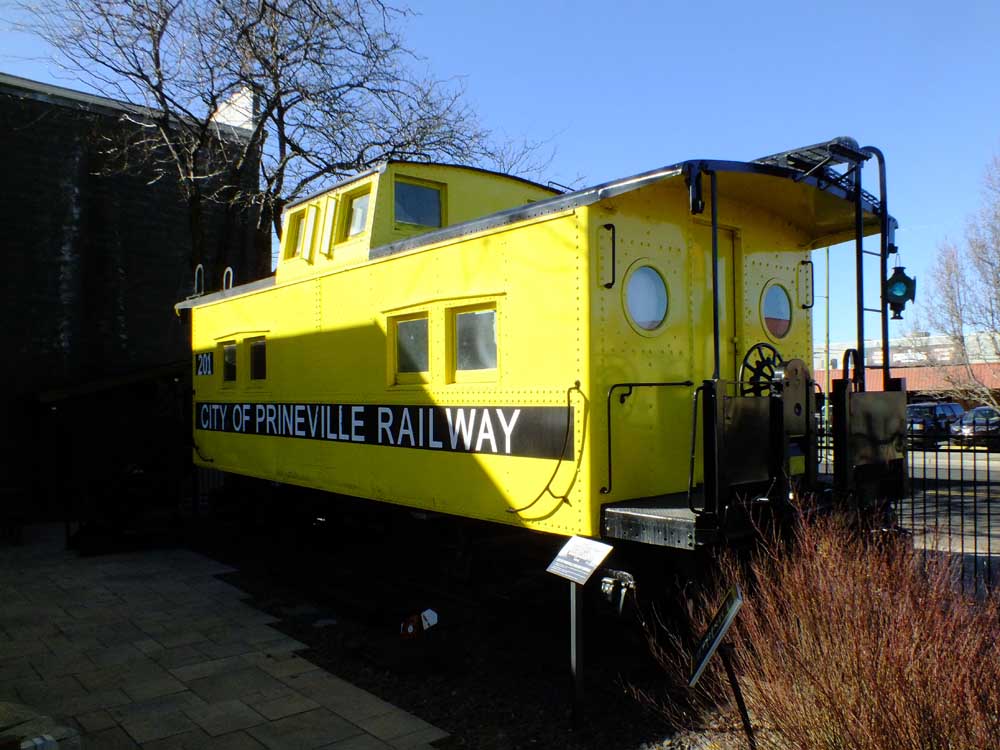 |
|
Former COP caboose #201 on display in the Crook County Museum in downtown Prineville. |
|
|
Map |
|
|
Locomotive roster Underlined numbers indicate a link to a page of pictures of that locomotive. Steam Locomotives #1- Portland 4-4-0, c/n ?, built 1883. Cylinders 16x24, Drivers 63", Weight 96,500 lbs. Built for Northern Pacific Railroad; to Spokane & Inland Empire; to City of Prineville #1 1918; Damaged in engine house fire 1925 and scrapped. Only coal burning locomotive on road. #2- Schenectady 2-6-0, c/n 2872, built 1889. Cylinders 18x24, Drivers 57", Weight 108,100 lbs. Built as Oregon Railway & Navigation Company #91, to Union Pacific #1211, to OR&N #107, to Oregon-Washington Railroad & Navigation Company #107, to Union Pacific #4204, to Brooks-Scanlon Lumber Company #2, to City of Prineville #2 1925. Retired 1948 and scrapped 1951. No known #3 #4- New York 2-8-0, c/n 429, built 1888. Cylinders 20x24, Drivers 51", Weight 129,000 lbs. Built as Oregon Railway & Navigation Company #82, to Union Pacific #1290, to Oregon-Washington Railroad & Navigation Company #160, to Union Pacific #700. Leased from Union Pacific for a period of time before purchased from UP on 15 November 1940. Retired 1945, scrapped 1947. #5- Baldwin 2-8-2T, c/n 53146, built 1920. Cylinders 16x22, Drivers 41", Weight 124,500 lbs. Built as Simpson Logging Company #2, to Weyerhaeuser Timber Company #2, to Weyerhaeuser #102, to City of Prineville #5 March 1941. Retired and scrapped 1945. #6- Rogers 2-8-0, c/n 5657, built 1901. Cylinders 23.5x32, Drivers 55", Weight 182,000 lbs. Built as Great Northern #1102, to City of Prineville July 1945. Scrapped 1955. #7- Manchester 0-6-0, c/n 44741, built 1907. Cylinders 20x26, Drivers 51", Weight 150,000 lbs. Built as Spokane Portland & Seattle #2; to City of Prineville July 1946. Retired 1950, scrapped 1952. Diesel Locomotives #101- Alco S-1, c/n 77079, blt 4/1950. 660 horsepower. Purchased new by City of Prineville; Retired 1984. To Salina Grain Terminal (Wolcott, KS); to Smoot Grain (Wolcott, KS); to ADM/Growmark-Wolcott Elevator (Wolcott, KS). #102- Alco S-1, c/n 69596, blt. 10/1941. Built as Spokane Portland & Seattle #10, to City of Prineville #102 1961. Retired 1984. To Far-Mar #102 (Kansas City, KS), to Union Equity Grain #102 (Kansas City, KS), to Farmland Industries #102 (Kansas City, KS). #103- Alco S-3, c/n 79774, blt 5/1052. Built as Brooks-Scanlon Corp. #102, to Oregon & Northwestern Railroad #102 1956, to City of Prineville #103 circa 1968. Retired 1984. To Kewash Railroad, Keota, IA early 1980s; to Dakota Southern, Chamberlin, SD. Scrapped December 2021/January 2022. #985- EMD GP-9, c/n 19569, blt 6/1954. Built as Chicago, Milwaukee, St. Paul & Pacific (MILW) #2406, re-numberd MILW #217, re-numbered MILW #985. Re-built by MILW. To City of Prineville #985 1984. Sold to Western Rail and scrapped May 2020. #989- EMD GP-9, c/n 20029, blt 11/1954. Built as Chicago, Milwaukee, St. Paul & Pacific (MILW) #2388, re-numberd MILW #238, re-numbered MILW #989. Re-built by MILW. To City of Prineville #989 1984. In service. #1001- Alco HH1000, c/n 69147, blt 1939. Built as Newburgh & South Shore #1, to City of Prineville #1001 1955. Retired 1961, then used as parts source for #101 and #102 until sold to Alaska Junk in 1963. #1551- EMD SW-1500, c/n 33992, blt 7/1968. Originally Southern Pacific #2505; to Wisconsin Central #1551; to Joseph Transportation #1551; to Relco #1551; to COP #1551 2014. Primary locomotive used on railroad today. #1837- EMD GP-9, c/n 21258, blt 4/1956. Built as Great Northern #685; to Burlington Northern #1837; to Joseph Simon & Sons #1837, Tacoma, WA; to General Metals #1837, Tacoma, WA; to Locomotives Northwest, Ltd. (Peter J. Replinger) #1837, Shelton, WA; to City of Prineville #1837 1996. Used as back-up locomotive today. #1859- EMD MP15DC, c/n 827018-9, blt 11/1982. Built as Missouri Pacific #1384; to Union Pacific #1384, then UPY #1384; to WRIX #1384; to Coos Bay Rail Line #1384, then #1859; to City of Prineville #1859 2024. |
|
|
|
Photos of the City of Prineville Railroad City of Prineville Alco-Powered Freights Cliff West photos John Henderson photos Two GP-20s Together 2004 Freight Operations- A Photo Essay by Rick Selby April 2019 Freight Operations- A Photo Essay by Matt C. Batryn-Rodriguez |
|
|
|
References Books Rails to the Ochoco Country- The City of Prineville Railway by John F. Due and Frances Juris, Golden West Books, San Marino, California, 1968. Railroads Down the Valleys- Some Short Lines of the Oregon Country by Randall V. Mills, Pacific Books, Palo Alto, California, 1950. Green Gold- The incomplete, and probably inaccurate, history of the timber industry in parts of Central and Eastern Oregon from 1867 to near the present by Martin Gabrio Morisette, Pacific Books, Self Published, 2005. Stations West, The Story of the Oregon Railways by Edwin D. Culp, Caxton Printers, Caldwell, Idaho, 1972. Main Streets of the Northwest, Rails from the Rockies to the Pacific by T.O. Repp, Trans-Anglo Books, Glendale, California, 1989. American Shortline Railway Guide by Edward Lewis. 2nd Addition, The Baggage Car, Morrisville, VT, 1978; 3rd Edition, Kalmbach, Waukesha, WI, 1986; 4th Edition, Kalmbach, Waukesha, WI, 1991; 5th Edition, Kalmbach, Waukesha, WI, 1996. Periodicals "City of Prineville Railway", September 1964 Pacific RailNews, pgs 3-8. "City of Prineville Railway" by Chris D'Amato, September 1978 Railfan, pgs 34-36. "The City of Prineville Railway: A Western shortline that you can model" by Harry Bonham, October 1993 Railroad Model Craftsman, pgs 85-92. "City of Prineville Railway" by Bill Buchanan, November 1998 RailNews, pgs 84-85. News Items from the Following Publications: Pacific RailNews Flimsies...Northwest! Northwest Railfan Bend Bulletin |
|
|
|
More on the Web City of Prineville Railway homepage City of Prineville Page on Western Shortline Rosters. Rob Jacox's Western Rails site. Some photos of COP locomotives on his Oregon Shortlines page. |
|
|